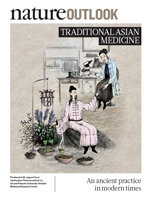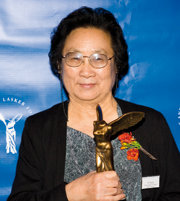

这是第一次国际顶级科学刊物上以专刊的形式报告亚洲传统医学(中医),继屠呦呦2011年9月问鼎拉斯科奖后中医再次被聚焦。
利用科技探究在中国和日本诸国使用的传统药物理念有助于从无依据的迷信中筛选出有效的疗法,还可能让现代医学深入了解基于数千年的中药而诞生的整体方法
专刊共有12篇文章,分别围绕中医的基本理念,中医临床,中医现代化,中草药及环境保护等主题展开讨论
前言
《nature》专刊系列副主编Michelle Grayson:
对一个根植于欧洲,以报告严谨科学事实著称的杂志而言,以专刊的形式向科学界及读者介绍东方传统医学,这样一门裹着神秘面纱并被不少人认为是伪科学的临床实践,似乎不太合适。虽然已经有少数成功案例存在,如治疗疟疾的青蒿素和治疗白血病的三氧化二砷,中医学治疗仍缺乏科学依据。但是,在中国和日本大力推进中医现代化的同时,我们注意到,西方的现代医学实践者们开始接纳一些中医重要理念,尤其是整体观理念。他们开始认同某些疾病的病因是由多方面因素引起的机体不平衡而造成,而非单一或局部病因,治疗应从整体入手。Michelle 指出,由于中医本身的特殊性,使得随机临床对照试验极难实施。但随着现代医学的越来越强调个性化治疗,生物和遗传标志物的发展,最终将会发掘出一套合适的工具来解决这个难题。Michelle在结语中写道,青蒿素和三氧化二砷的发现并不代表传统医学和现代医学的理想结合。如果能找到巧妙合理的研究方法,传统医学中的独特理论也将会大放异彩(而不仅仅是传统医学中的药物)。同时,科学界也要尽最大努力将传统医学中的精华与其伪科学糟粕分离。
第一篇:传统中医医学的发源地——中国
Traditional medicine — a system of ancient medical practice that differs in substance, methodology and philosophy to modern medicine — plays an important role in health maintenance for the peoples of Asia, and is becoming more frequently used in countries in the West.
第二篇:当西医遇到中医,会碰撞出什么样的火花?
Convergence: Where West meets East
For around 200 years, two very different systems of medicine have been used in Asia to cure diseases and keep people healthy. The local Asian one is based on traditional Chinese medicine (TCM) — herbal mixtures developed though observation and experience accumulated over thousands of years, but with unknown mechanisms of action. On the other hand, modern medicine, imported from the West, consists of chemically purified compounds that have been discovered through scientific investigation and tested in controlled clinical trials. They differ in the composition of their medicines, the process of diagnosis, methods of proving a treatment's effectiveness, and even in their concept of 'health' .
Are these differences irreconcilable? Or, if TCM is modernized to the point where it can make scientifically valid claims, might it offer new perspectives that can benefit modern medicine — including clues on how to tackle the least tractable diseases and conditions? And likewise, can new perspectives being advanced in the West, such as systems biology, help lay a scientific foundation for TCM?
第三篇:
Systems science can provide guidance in capturing the complementary approaches to healthcare, says Jan van der Greef.
Various cultures have developed their own philosophies of science and, consequently, practices in medicine. The twentieth century has seemed to vindicate the Western approach, bringing huge advances in our understanding of physiology and biochemistry. This knowledge has fuelled the development of medicines and vaccines against countless diseases that had once wreaked havoc on humanity.
A flock of starlings relies on connectivity, dynamics and communication; these elements are embedded in TCM.
第四篇:
Microbiome: That healthy gut feeling
许多传统草药成分不能被人体肠道吸收。Could our microbial inhabitants do for us what we can't do ourselves?
第五篇:
Modernization: One step at a time


药草养植标准在2002年被引入中国,帮助规范草药原材料
第六篇:专利——保护中国的传统医学
Patents: Protecting China's national treasure
Protection offered by the current system is weak at best.当前系统提供的保护充其量是非常薄弱的
第七篇:
Nature China的编辑报告了他第一次访问中国传统的中医的经历,了解古老的中医在二十一世纪是如何实践的,看看是否可以做一些事情,以减轻他的背部疼痛。
I had never tried acupuncture before, so my TCM doctor, Xiuhua Chen, gave me a trial run by inserting a needle behind my ear.
第九篇:
Traditional plant-based remedies are not risk-free. Doctors and patients need to be informed about the possible side effects, says Masatomo Sakurai.
第十篇:
Regulations: Herbal medicine rule book
Can Western guidelines govern Eastern herbal traditions?
第十一篇:
Perspective: The clinical trial barriers
Western medicine depends on science to create and assess drugs at the molecular level. In Asia, there is a commonly held belief that there is an art to healing too, and that both art and science should cooperate to help eradicate illness and relieve suffering.
Liang Liu
楼主解读这篇文章辛苦,顶一个!
最近又看到一条新闻,研究人员找到了针灸降血压的一个分子,神经肽类的物质,从这方面说明中医还是有物质基础的,所以,现在对于中医药现代化的问题是,以什么样的方式,由谁来把中医的奥妙用现代医学的理论解释出来让更多的人认同。